|
Nouveau :
Films!
New:
Films!
Mécanisme
Mechanism
Manuel
Manual
|
Mon signal nain! — My dwarf signal!
Depuis
que j'ai vu un sémaphore d'ordres de marches orner le salon
d'un éminent ferrovipathe, j'ai toujours rêvé
d'avoir un signal quelconque, préférablement lumineux...
18 ans plus tard, j'ai été magnifiquement
exaucé :
Since I saw a train-order board in a famous railfan's
living-room, I have been dreaming of having some kind of signal, preferably
electric...
18 years later, my wish has been magnificently fulfilled:
Boîtier extérieur — External
housing
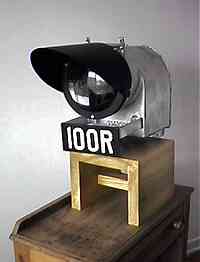
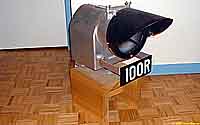 Ce
signal nain était, selon sa plaque numérique, à environ
un mille (1600m) au sud de la Gare Centrale de Montréal, sur la
subdivision de Montréal. Ce
signal nain était, selon sa plaque numérique, à environ
un mille (1600m) au sud de la Gare Centrale de Montréal, sur la
subdivision de Montréal.
C'est un signal typique de type "searchlight"
qui peut afficher trois couleurs, grâce à un jeu de filtres
de couleur mobile placé entre la lampe et la première lentille.
Avec le clignotement, ce signal peut afficher en théorie un maximum
de six aspects différents.
This dwarf signal was, according to it's number
plate, about one mile (1600m) south of Central Station in Montréal,
on the Montréal subdivision.
This is a typical searchlight-kind
signal, which can display three colours, thanks to a movable filter located
between the bulb and the first lens. With blinking aspects, this signal
can show in theory a maximum of six different aspects.
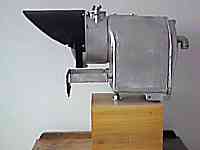 Lorsqu'il fut ramassé dans les poubelles du CN, il était
dans un très piètre état... Mais il a été
restauré (jet de sable, couche de peinture et nouvelles vis lorsque
nécéssaire). Le piédestal a été fait
spécialement pour exposer le signal nain dans mon salon; normalement,
un tel signal est monté sur un bloc de béton avec une base
articulée permetant de diriger précisément le faisceau
du signal nain. Par miracle, la lentille et le prisme étaient pratiquement
intacts.
Lorsqu'il fut ramassé dans les poubelles du CN, il était
dans un très piètre état... Mais il a été
restauré (jet de sable, couche de peinture et nouvelles vis lorsque
nécéssaire). Le piédestal a été fait
spécialement pour exposer le signal nain dans mon salon; normalement,
un tel signal est monté sur un bloc de béton avec une base
articulée permetant de diriger précisément le faisceau
du signal nain. Par miracle, la lentille et le prisme étaient pratiquement
intacts.
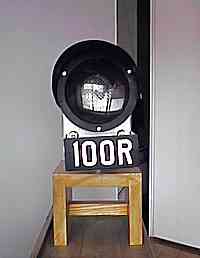 Ce type de signal a été inventé en 1920, aux États-Unis,
par la compagnie Hall. Cette compagnie a été rachetée
en 1925 par Union Switch & Signal Co. Son principal avantage est
la très basse consommation grâce à un faisceau très
étroit.
Ce type de signal a été inventé en 1920, aux États-Unis,
par la compagnie Hall. Cette compagnie a été rachetée
en 1925 par Union Switch & Signal Co. Son principal avantage est
la très basse consommation grâce à un faisceau très
étroit.
When discovered in CN's garbage, it was in a very poor condition...
But it was restored (sandblast, paint and new screws when needed). The
base was made specially to exhibit the dwarf signal in my living room;
normally, such a signal is mounted on a concrete block with an articulated
bracket which allows aiming the signal beam precisely. By miracle, the
lens and prism were pratically intact.
This kind of signal was invented in 1920 in the USA
by the Hall Signal Co. This company was in turn bought in 1925
by the Union Switch & Signal Co.. The advantage of this kind of
signal is the very low power consumption thanks to the extremely narrow
beam.
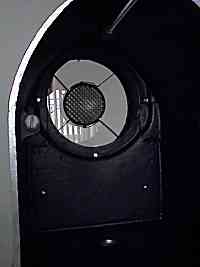 Il
y a, au centre de la lentille extérieure (qui fait 20 cm de diamètre)
un petit prisme fresnel qui dévie une portion du faisceau très
focalisé vers l'intérieur de la voie, afin d'être
visible au mécanicien d'un train qui s'arrête à
proximité.
Il
y a, au centre de la lentille extérieure (qui fait 20 cm de diamètre)
un petit prisme fresnel qui dévie une portion du faisceau très
focalisé vers l'intérieur de la voie, afin d'être
visible au mécanicien d'un train qui s'arrête à
proximité.
Originalement, j'ai obtenu le signal sans le dispositif
optoélectrique interne, mais j'ai pu finalement
en obtenir un en mars 2002.
There is in the middle of the external lens (20
cm diameter) a small fresnel prism which bends a part of the narrowly-focused
beam so the engineer of a train stopped next to the signal can see it.
Originally, when I obtained the signal, it went wigtout
the internal optoelectric mechanism, but I finally
obtained one in March 2002.
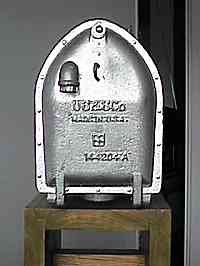 Il est fort possible que ce signal date de 1944, soit l'ouverture
de la Gare Centrale. Il est difficile de le retracer, car il figure toujours
au catalogue du constructeur (Union
Switch & Signal, n° 144203A), et cela depuis les années
30...
Il est fort possible que ce signal date de 1944, soit l'ouverture
de la Gare Centrale. Il est difficile de le retracer, car il figure toujours
au catalogue du constructeur (Union
Switch & Signal, n° 144203A), et cela depuis les années
30...
Les dimensions sont 67 cm de hauteur par 73 cm de profondeur
par 30 cm de large.
It is very possible that this signal dates from 1944, the opening of Central
Station. It is difficult to tell, since it is still in the manufacturer's
catalogue (Union Switch
& Signal, # 144203A), and that is since the 1930's...
Dimensions are 67 cm height, 73 cm depth and 30 cm width.
La forme ogivoïdale du boîtier surprend un peu. Le boîtier
est constitué de fonte, ce qui le rend fragile (et lourd! Le tout,
avec le mécanisme, pèse près de 30 kilos); de grosses
fissures dans la base, à l'endroit où entre le conduit
de fils électriques sont probablement la raison pour laquelle il
aurait été retiré du service...
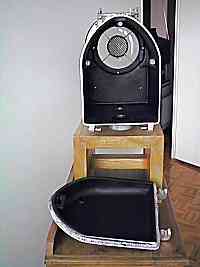 On constatera que les charnières sont carrément
rompues sur la porte arrière. Cette dernière est pressée
contre le boîtier par une vis au faîte de l'ogive; la
tête de cette vis est particulière (elle n'a pas été
trouvée et est donc remplacée ici par une vis ordinaire),
car elle comporte un bras qui permet de la verrouiller sur l'arceau
au centre, à côté du ventilateur avec un cadenas.
L'étanchéité est assurée par un gros bourrelet
de canevas (enlevé lors de la restauration).
On constatera que les charnières sont carrément
rompues sur la porte arrière. Cette dernière est pressée
contre le boîtier par une vis au faîte de l'ogive; la
tête de cette vis est particulière (elle n'a pas été
trouvée et est donc remplacée ici par une vis ordinaire),
car elle comporte un bras qui permet de la verrouiller sur l'arceau
au centre, à côté du ventilateur avec un cadenas.
L'étanchéité est assurée par un gros bourrelet
de canevas (enlevé lors de la restauration).
The ogivoid shape of the case is a bit surprising. The case is made of
cast-iron, which makes it fragile (and heavy! The whole, with the mechanism,
weighs almost 30 kilos); big cracks where the electrical conduit goes
into the case is probably the reason the signal was retired... One will
notice that the hinges for the access door are broken. The latter is pressed
against the case by a screw at the top of the case; the head of that screw
is interesting (it was not found and replaced by a normal screw), since
it has a special arm that allows it to be locked with a padlock on the
hook in the middle, besides the ventilator. Watertightness is effected
by a big canvas wad (removed during restoration).
Mécanisme interne — Internal
mechanism
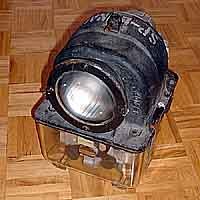 Donc,
j'ai finalement obtenu, en mars 2002, un mécanisme interne permettant
d'afficher trois couleurs : le rouge ,
le jaune et le blanc
lunaire . Blanc lunaire désigne un blanc bleuâtre
ne pouvant pas être confondu avec un blanc "ordinaire".
Ce mécanisme provient du Southern Pacific, dont le règlement
d'exploitation comporte des aspects
de signaux curieux, utilisant notamment le blanc lunaire (règle
289, signal de marche à vue). Donc,
j'ai finalement obtenu, en mars 2002, un mécanisme interne permettant
d'afficher trois couleurs : le rouge ,
le jaune et le blanc
lunaire . Blanc lunaire désigne un blanc bleuâtre
ne pouvant pas être confondu avec un blanc "ordinaire".
Ce mécanisme provient du Southern Pacific, dont le règlement
d'exploitation comporte des aspects
de signaux curieux, utilisant notamment le blanc lunaire (règle
289, signal de marche à vue).
So, I finally was able to get, in March 2002, the internal
mechanism that displays three colours: red ,
yellow and lunar
white . Lunar white is a bluish white that cannot be taken
for an "ordinary" white. This mechanism comes from the Southern
Pacific, whose operating rules allows bizzare
signal aspects, using the lunar white colour (rule
289, restricting signal).
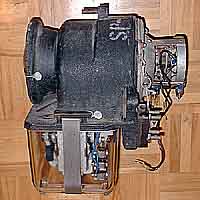 Vu
de côté, on a, en haut à gauche, la lentille, puis
(sous les lettres "SP"), l'emplacement où se trouvent
les filtres de couleur, puis le réflecteur parabolique où
se trouve l'ampoule. En dessous, dans le boîtier de verre, se trouvent
les bobines de commande des filtres de couleur ainsi que deux contacts
destinés à confirmer le bon fonctionnement du signal. Vu
de côté, on a, en haut à gauche, la lentille, puis
(sous les lettres "SP"), l'emplacement où se trouvent
les filtres de couleur, puis le réflecteur parabolique où
se trouve l'ampoule. En dessous, dans le boîtier de verre, se trouvent
les bobines de commande des filtres de couleur ainsi que deux contacts
destinés à confirmer le bon fonctionnement du signal.
Looking at the side, we have on the top left, the lenst,
then (under the "SP" letters), the location of the roundels
(colour filters), then the parabolic reflector where the light-bulb is
located. Below, within the glass housing, we find the roundel-actuating
coils as well as two contacts which make sure the signal operates properly.
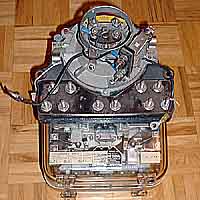 L'arrière
du mécanisme est bien garni : en haut, le cercle gris est
la douille pour l'ampoule, avec un rhéostat destiné à
ajuster l'intensité de l'ampoule. Juste dessous, on a les bornes
où se branchent les fils d'alimentation et de commande. Les deux
contacts du centre commandent les bobines actionnant le signal; l'affichage
de la couleur est commandé par la polarité et l'absence
de courant (voir la table plus bas). Et le boîtier en verre donne
une vue imprenable sur le mécanisme... L'arrière
du mécanisme est bien garni : en haut, le cercle gris est
la douille pour l'ampoule, avec un rhéostat destiné à
ajuster l'intensité de l'ampoule. Juste dessous, on a les bornes
où se branchent les fils d'alimentation et de commande. Les deux
contacts du centre commandent les bobines actionnant le signal; l'affichage
de la couleur est commandé par la polarité et l'absence
de courant (voir la table plus bas). Et le boîtier en verre donne
une vue imprenable sur le mécanisme...
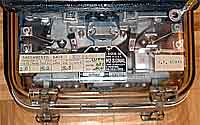 The
back of the mechanism is well furnished: on top, the gray circle is the
light-bulb socket, with a rheostat to adjust the bulb intensity. Right
below, the terminals where the control and power-supply wires are connected.
The two terminals in the center are the signal coil contacts; the colour
displayed is selected by the polarity and the absence of power (see table
below). And the glass housing gives real good view of the mechanism... The
back of the mechanism is well furnished: on top, the gray circle is the
light-bulb socket, with a rheostat to adjust the bulb intensity. Right
below, the terminals where the control and power-supply wires are connected.
The two terminals in the center are the signal coil contacts; the colour
displayed is selected by the polarity and the absence of power (see table
below). And the glass housing gives real good view of the mechanism...
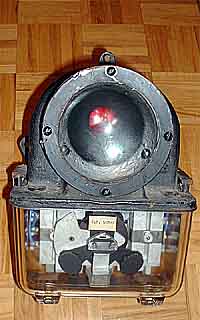 Au
devant, on a la lentille; on aperçoit, au centre, la réflection
du flash dans le réflecteur parabolique colorée en rouge,
du fait qu'elle passe au travers du filtre rouge. Un aspect intéressant
de la conception des signaux lumineux est l'absence totale de surfaces
réfléchissantes à l'intérieur, à l'exception
des endroits où la lumière n'est pas coloriée. Cela
a pour but d'éviter une indication erronée causée
par de la lumière incidente. Dans le cas d'un signal H-2, le seul
réflecteur est le réflecteur autour de l'ampoule; le reste
du signal, depuis les filtres de couleur, est peint en noir mat afin d'absorber
toute lumière parasite. Un signal à trois lentilles n'aura
aucun réflecteur derrière l'ampoule par exemple. Au
devant, on a la lentille; on aperçoit, au centre, la réflection
du flash dans le réflecteur parabolique colorée en rouge,
du fait qu'elle passe au travers du filtre rouge. Un aspect intéressant
de la conception des signaux lumineux est l'absence totale de surfaces
réfléchissantes à l'intérieur, à l'exception
des endroits où la lumière n'est pas coloriée. Cela
a pour but d'éviter une indication erronée causée
par de la lumière incidente. Dans le cas d'un signal H-2, le seul
réflecteur est le réflecteur autour de l'ampoule; le reste
du signal, depuis les filtres de couleur, est peint en noir mat afin d'absorber
toute lumière parasite. Un signal à trois lentilles n'aura
aucun réflecteur derrière l'ampoule par exemple.
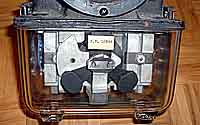 In
front, we see the lens; in the middle, we see the flash reflection into
the parabolic reflector coloured in red, since it passed through the red
roundel. An interesting design aspect of railroad signals is the total
absence of reflective surfaces inside, except where the light has not
been coloured. This is to avoid phantom indications caused by indicent
light. In the case of a H-2 signal, the only reflector is around the light
bulb; the remainder of the signal, from the roundels, is painted in a
dull black to absorb any parasite light. A three lens signal will have
no reflector behind the light bulb, for example. In
front, we see the lens; in the middle, we see the flash reflection into
the parabolic reflector coloured in red, since it passed through the red
roundel. An interesting design aspect of railroad signals is the total
absence of reflective surfaces inside, except where the light has not
been coloured. This is to avoid phantom indications caused by indicent
light. In the case of a H-2 signal, the only reflector is around the light
bulb; the remainder of the signal, from the roundels, is painted in a
dull black to absorb any parasite light. A three lens signal will have
no reflector behind the light bulb, for example.
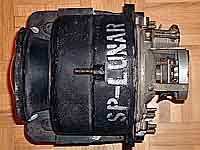 On
aperçoit, au dessous, le mécanisme. Les deux contrepoids
noirs ramènent le signal à la position rouge; afin d'éviter
tout risque de bris de ressort, les relais ferroviaires utilisent la gravité;
le signal H-2 ne fait pas exception à cette règle... On
aperçoit, de part et d'autre des contrepoids, les pièces
polaires de commande du signal. Selon la polarité appliquée
à la bobine, il ira dans une ou autre direction, entraînant
le filtre coloré approprié dans le dispositif optique. Le
tout est scellé de façon très zélée,
l'environnement extérieur étant toujours hostile à
la mécanique délicate... On
aperçoit, au dessous, le mécanisme. Les deux contrepoids
noirs ramènent le signal à la position rouge; afin d'éviter
tout risque de bris de ressort, les relais ferroviaires utilisent la gravité;
le signal H-2 ne fait pas exception à cette règle... On
aperçoit, de part et d'autre des contrepoids, les pièces
polaires de commande du signal. Selon la polarité appliquée
à la bobine, il ira dans une ou autre direction, entraînant
le filtre coloré approprié dans le dispositif optique. Le
tout est scellé de façon très zélée,
l'environnement extérieur étant toujours hostile à
la mécanique délicate...
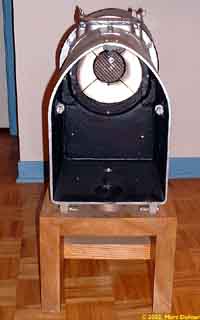 You
can see at the bottom the mechanism. The two black counterweights recall
the signal to the red position; so to prevent any risk of spring break,
railroad signal relays use gravity; the H-2 signal is no exception to
this rule... You can see, on either side of the counterweights, the pole
pieces of the signal actuator. According to the polarity applied to the
coil, it will go towards one side or the other, moving the appropriate
roundel into the optical path. Everything is sealed in a rather zealous
way, the external environment being always hostile towards delicate mechanisms... You
can see at the bottom the mechanism. The two black counterweights recall
the signal to the red position; so to prevent any risk of spring break,
railroad signal relays use gravity; the H-2 signal is no exception to
this rule... You can see, on either side of the counterweights, the pole
pieces of the signal actuator. According to the polarity applied to the
coil, it will go towards one side or the other, moving the appropriate
roundel into the optical path. Everything is sealed in a rather zealous
way, the external environment being always hostile towards delicate mechanisms...
 L'installation
du mécanisme est facile à faire: il suffit de le glisser
à l'intérieur, près du haut; une tige entre dans
un anneau, et le tout est gentiment suspendu; deux boulons de chaque-côté
servent à fixer le tout. Une fois le mécanisme installé,
il ne reste guère de place pour passer les fils... Gageons que
le métier d'entreteneur de signaux est un métier zen... L'installation
du mécanisme est facile à faire: il suffit de le glisser
à l'intérieur, près du haut; une tige entre dans
un anneau, et le tout est gentiment suspendu; deux boulons de chaque-côté
servent à fixer le tout. Une fois le mécanisme installé,
il ne reste guère de place pour passer les fils... Gageons que
le métier d'entreteneur de signaux est un métier zen...
The mechanism is easily installed: you merely slide the
mechanism inside, near the top; a pin enters a ring and the whole thing
is gently suspended; two bolts on either side secure everything. Once
the mechanism is installed, there is no much room left to run the wiring...
I suppose that signal maintainer is a zen occupation...
Fonctionnement — Operation
Bon! Trève de cadembrelaines! Passons aux choses sérieuses!
Branchons le tout, et admirons le fonctionnement de cet admirable mécanique:
Good! Enough trivialities! Lets move to serious things!
Let's power-up everything and oogle in front of this magnificent apparatus
working:
ROUGE
RED
|
BLANC LUNAIRE
LUNAR WHITE
|
JAUNE
YELLOW
|
 |
 |

|
 |
 |

|
|
ROUGE
Aucun courant
l'armature est centrée,
ce qui met le filtre rouge
devant l'ampoule.
|
BLANC LUNAIRE
Courant positif
l'armature va à droite,
ce qui met le filtre blanc lunaire
devant l'ampoule.
|
JAUNE
Courant négatif
l'armature va à gauche,
ce qui met le filtre jaune
devant l'ampoule.
|
|
RED
No power
coil is centered,
which lines the red roundel
in front of the bulb.
|
LUNAR WHITE
Positive power
coil moves to the right,
which lines the lunar white roundel
in front of the bulb.
|
YELLOW
Negative power
coil moves to the left,
which lines the yellow roundel
in front of the bulb.
|
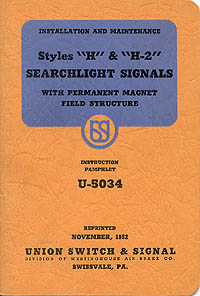 Le
manuel d’instruction Le
manuel d’instruction
The instruction manual
J'ai réussi à dénicher un exemplaire du manuel d'instruction
pour ce signal datant de 1952!
Union Switch & Signal Instruction
Pamphlet U-5034
I managed to secure an instruction manual for this signal
dating from 1952!
Des films du signal en fonctionnement —
Movies of the signal in operation
En essayant une caméra numérique empruntée, j'ai
fait trois films (Quicktime) montrant le fonctionnement du signal.
While trying-out a borrowed digital camera, I made three
(Quicktime) movies showing the signal in operation.
Quelques liens — Some links
Union Switch
& Signal — Le manufacturier – The
manufacturer
US&S
Searchlight Signals — La page d'un collectionneur – A
collector's page
C'est tout pour aujourd'hui!
That's all, folks!
|
![]()
![]()